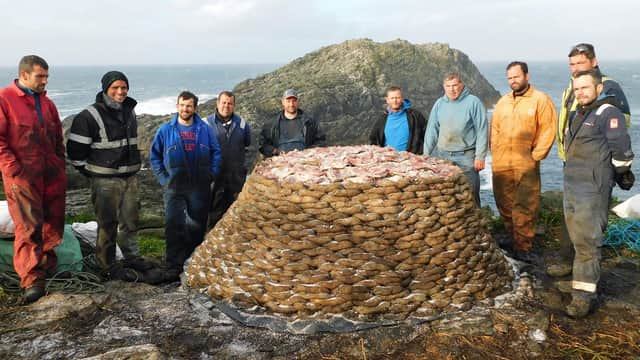Guga trade-off would be “ethically wrong”


The plan has been met with astonishment in Ness where no consultation was initiated by SSE Renewables before submitting the scheme to NatureScot and the Scottish Government.
As part of a bid to gain approval for its massive Berwick Bank offshore wind farm in the outer Firth of Forth, the energy giant provided a detailed rationale for trading potential damage to bird stocks against a cut in the Sula Sgeir licence, from 2000 to 1000 birds annually.
Advertisement
Advertisement
The company stressed on Wednesday that they do not believe compensation measures for gannet losses in relation to Berwick Bank are necessary and that they are “not advocating” a reduction in the annual guga cull.
The guga expedition was not held this year or last due to the outbreaks of Avian flu but there is every intention to resume it when normal conditions return.
The 4.1 GW Berwick Bank windfarm project, which SSE describe as “one of the largest offshore opportunities in the world” has been in development for more than a decade but continues to face opposition from environmental organisations, including the Scottish Seabird Centre at North Berwick.
One of the concerns is the alleged impact on Bass Rock which is home to the UK’s biggest gannet population. In an effort to mitigate against this, SSE Renewables has now put forward the Sula Sgeir trade-off “should Scottish Ministers conclude gannet compensation is required”.
Advertisement
Advertisement
Their submission emphasises the range of travel undertaken by gannets and claims: “Reducing the (Sula Sgeir) harvest is considered highly likely to result in the growth of the colony and other colonies in the north-east Atlantic metapopulation of gannet”.
It quotes research from 2004 which suggested that “the rate of growth (in breeding numbers) at Sula Sgeir is far below the expected rate, whereas by contrast Bass Rock lies well above the expected rate”.
The Bass Rock gannet population was five times greater than Sula Sgeir’s whereas in 1969 they were “of similar size”.
The submission from SSE Renewables continues: “The Applicant will actively engage with the Men of Ness to facilitate a negotiated agreement to reduce cull numbers and consider additional benefits that could be provided.
Advertisement
Advertisement
“If this is unsuccessful the measure can be secured by NatureScot via the mechanism of reducing the cull in the annual licence granted for as long as compensation is required to offset impacts from Berwick Bank.
The paper notes that the Sula Sgeir licence “has been gradually reduced from around 3500 guga to 2500 and is now set at 2000".
It continues: “Although simple population modelling indicates that the harvest is sustainable, the harvest has reduced the rate of population growth at Sula Sgeir relative to other colonies.
“The Sula Sgeir population may therefore act as a sink for emigrant gannets from other colonies and ending the hunt could lead to increased growth of the surrounding colonies. For this reason, reduction of the annual gannet hunt has been identified as being the most feasible mechanism to compensate for potential losses of gannet.”
Advertisement
Advertisement
The SSE Renewables document was publicised via X (formerly Twitter) by Murdo MacRitchie from Skigersta, Ness, whose attention had been drawn to it by someone who was not in a position to “go public”. It had been lodged in August.
Mr MacRitchie posted: “Now this is interesting. How Sula Sgeir is getting rolled into a FTSE100 company and a Scottish Gov agency’s deal making. Impact on gannet mortality in Berwick Banks being ‘funded’ by a 50 per cent reduction in the Sula Sgeir hunt licence. Zero contact with Ness”.
Mr MacRitchie told the Gazette: “It just seems wrong on every level – morally, ethically and the fact something like this can be going on behind the scenes with absolutely no local awareness. It is grubby and I hope NatureScot will deal with it in the appropriate way”.
Prospective Labour candidate, Torcuil Crichton, said: “It is disappointing to find a Scottish company which owes so much to the Highlands and Islands creating unnecessary mistrust. The Scottish Government should make clear that the trade they offer is unacceptable and that some things are not for sale”.
Advertisement
Advertisement
An SSE Renewables spokesman said they were not advocating a reduction in the guga hunt but putting forward a scenario in the event of gannet “compensation” being required, which they do not believe to be necessary.
Their statement said: ”As part of the extensive consenting process for Berwick Bank offshore wind farm we were asked to provide additional information on wider gannet population compensation measures.
“As the paper says, we provided this for information purposes and ‘without prejudice’. Separately, we have made the case that no measures are needed for the gannet population as a result of the Berwick Bank project.”.